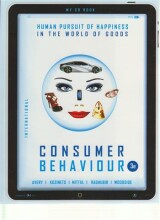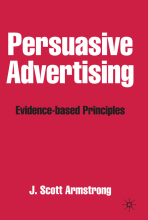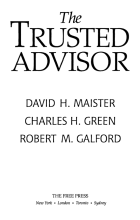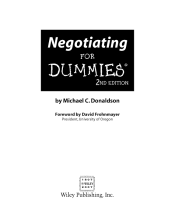Summary: Consumer Behaviour Human Persuit Of Happiness In | 9780979133640 | Jill Avery
- This + 400k other summaries
- A unique study and practice tool
- Never study anything twice again
- Get the grades you hope for
- 100% sure, 100% understanding
Read the summary and the most important questions on Consumer behaviour human persuit of happiness in | 9780979133640 | Jill Avery ...
-
2 Motivation
-
2.1 Consumer motivation
This is a preview. There are 6 more flashcards available for chapter 2.1
Show more cards here -
Explain the model of consumer motivation
Desired state
| --> Tension (felt discomfort) --> Drive (energy) --> Goal object (something that will reduce the tension)
Actual stateThe greater the pressure, the greater the released force/drive. Drive provides the energy to act, goal object provides the direction in which to channel that energy.
-
What is purposive behavior?
Motivated behavior, the use of energy to attain a goal object.
-
Where comes the want in the consumer decision model?
The desire for a particular goal object is a consumer want.
Thus needs provide the drive, and the goal object provides the want.
Our needs and wants makes us different consumers. -
What type of need is a face-lift?
A psychogenic need, this needs stems from our psychological makeups, our ways of thinking.
-
Explain the two types of motivations.
- Approach motivation: desire to attain a goal object.
- Avoidance motivation: desire to protect oneself from an object.
Also called appetitive and aversive motivation. -
What is a approach-avoid conflict?
We experience this conflict when we find an object both desirable as undesirable, e.g. a product that has positive and negative features. Think of McDonalds, very nice food, but very unhealthy due to their fat and calorie content.
-
2.2 Maslow's model of hierarchy of needs
This is a preview. There are 7 more flashcards available for chapter 2.2
Show more cards here -
Can a product satisfy only one need or more?
A product is no longer tied to a specific need; it can now meet more than one need. Consumers must decide how many and which needs they want a product to satisfy. Therefore marketers must invent new versions of product classes so as to satisfy this new combinations of consumers' needs.
-
What is the problem of Maslow's needs?
It gives us answers in broad terms but not precisely. It paints everything with a broad brush, and as such it does not pinpoint consumer motivation at a level of detail.
Henry Murray proposed a list that will help us define consumer needs at a more detailed level than does Maslow. -
What was the philosophy of Ernest Dichter with regard to motivations.
He believed that unconscious motives play a significant role in people's consumption decisions.
Unconscious motives influence consumption decisions unconsciously, therefore Dichter's list of motives is most useful for incorporating symbolism into product advertising. -
2.3 Researching connsumer motives
This is a preview. There are 5 more flashcards available for chapter 2.3
Show more cards here -
There are two reasons why we would not learn, by direct questioning, what consumers' real motives for a given purchase might be.
- Motives might be unconscious (think of Dichter)
- Consumers might want to keep their motives private, e.g. it is not cool to reveal that you bought a car for status.
- Higher grades + faster learning
- Never study anything twice
- 100% sure, 100% understanding
Topics related to Summary: Consumer Behaviour Human Persuit Of Happiness In
-
Motivation - Researching connsumer motives
-
Motivation - Consumer emotions
-
Motivation - Consumer moods
-
Motivation - Hedonic consumption
-
Motivation - Consumer involvement
-
Learning - Four models of consumer learning - Classical conditioning
-
Learning - Four models of consumer learning - Instrumental learning
-
Learning - Consumer information processing
-
Learning - Consumer adoption of product innovations
-
Learning - Consumer nostalgia
-
Decision models: compensatory and noncompensatory - Consumer values
-
Decision models: compensatory and noncompensatory - Consumer personality
-
Decision models: compensatory and noncompensatory - Self-concept
-
Attitudes - The ABC model of attitude
-
Attitudes - Hierarchies in attitude
-
Attitudes - Four functions of attitude
-
Attitudes - Multi-attribute models of attitude and behavior: tova, tora, tota
-
Persuasion - Attitude change: seven theories
-
Persuasion - How low involvement advertising works
-
Persuasion - Appeal types
-
Persuasion - Source credibility
-
Culture - Culture: definition
-
Culture - Cultural values
-
Culture - Cultural practices, rituals, customs and myths
-
Culture - Crossing cultures: marketing blunders
-
Decisions - The consumer decision process - Step 1: Problem recognition
-
Decisions - The consumer decision process - Step 2: Information search
-
Decisions - Search strategies and determinants
-
Decisions - Decision models
-
Decisions - Imperfections in consumer judgments
-
Decisions - Choosing expressive products
































